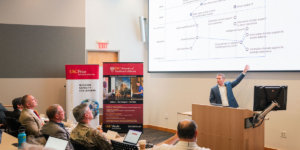The USC Viterbi School of Engineering will partner with Texas A&M in a new Homeland Security Center aimed a biological threats — and ISI will be a part of the effort.
ISI’s Integration Sciences Division, headquartered at ISI’s Arlington Virginia campus, will bring its expertise in distributed databases and pattern recognition with applications in law enforcement, inspection systems, and threat detection to bear on “Zoonotic Disease Defense,” according to division director John Damoulakis.”Zoonotic” diseases are those passed from animals to humans, such as malaria, plague, Rift Valley Fever and many others. The new National Center for Foreign Animal and Zoonotic Disease Defense, will receive $18 million in funding from the DHS to be distributed through a consortium of institutions that will include, besides USC and Texas A&M, the University of Texas Medical Branch, the University of California at Davis, Texas Tech University and the University of Maryland.
ISI senior project leader Robert MacGregor will also be part of the effort. MacGregor works in the emerging field of Semantic Web technology, creating systems that exploit machine-interpretable information structures to achieve more powerful kinds of interaction with information and people on the Web.
MacGregor is also developing simulation models for CREATE, the Department of Homeland Security Center for Risk and Economic Analysis of Terrorism Events, established in November, 2003 at USC as a joint project between the USC Viterbi School of Engineering and the USC School of Policy, Planning and Development.
Also involved in CREATE and the new center is Najmedin Meshkati, an associate professor in the USC Viterbi School’s department of civil/environmental engineering who is a widely known expert on risk management of complex, large-scale technological systems, with particular reference to human factors, and has consulted for many national and international organizations.
Published on April 30th, 2004
Last updated on August 9th, 2021













